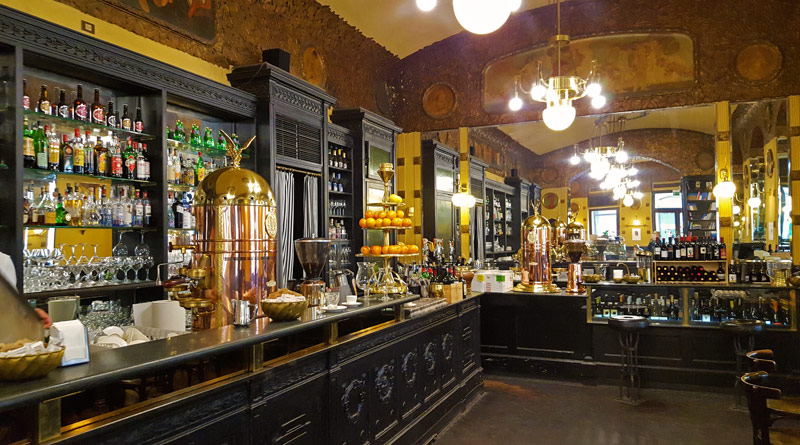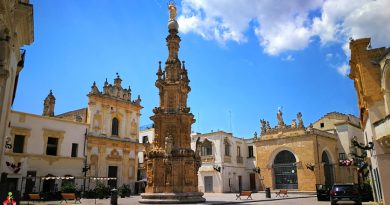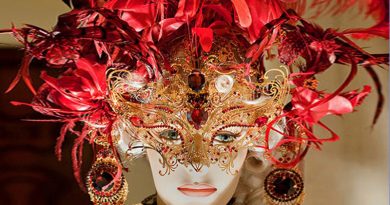Top 10 Historic cafés and pastry shops in Trieste
More than any other city in Italy, Trieste is inextricably linked to the world of coffee. Since the 18th century the Adriatic seaport has been the Mediterranean’s main coffee harbor, where the green beans arrive from around the world. The capital of the Friuli-Venezia Giulia region also serves as a global hub for the coffee roasting industry, with among the many small, local coffee roasting businesses also the world famous Triestine company, Illy. Add to that the city’s many historic cafés and you’ll understand why the aroma of freshly-roasted beans and brewed coffee is always swirling in the air.
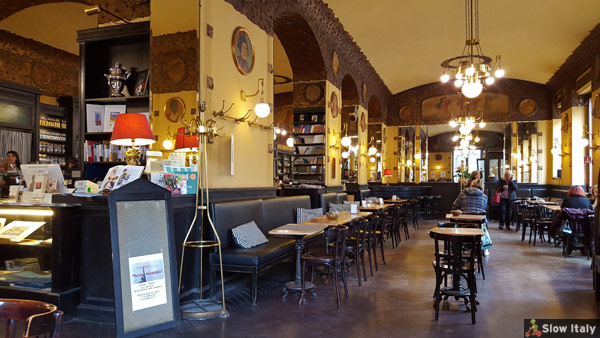
The unique rapport between the Triestines and their favorite brewage (the inhabitants of Trieste drink almost twice as much coffee as the rest of Italy, 10kg per capita a year versus 5.8kg for the national average) is even visible in their language. They have developed their own coffee jargon, only intelligible by the initiated, that can be rather confusing for the non-locals. See: How to order a coffee in Trieste.
Many of Trieste’s historic cafés used their own brands and blends of coffee, and some still do today. Actually, this is precisely what characterizes the coffee production in Trieste, which has no equivalent in the rest of Italy, except maybe in Naples and Palermo, where small coffee roasting businesses cater directly to Trieste’s coffee houses. This creates the rather unique experience of tasting a different coffee in every café.
Trieste’s first “coffee shop” (then called cafeteria) opened in Via S. Nicolo’ (formerly Contrada Bottari) in 1768. It was in fact not much more than a license to sell “hot and cold waters, tea, coffee, hot chocolate, lemonades and syrup water” in addition to the permission to have “biliard tables and bake biscuits”.
Just like a good blend of coffee is composed of beans of different flavors and origins, so is the city’s history and culture made of different languages and traditions, which is in turn reflected in its coffee houses. At first, each coffee house was associated with a clientele of specific origin. Stella Polare, for example, was mostly frequented by the German community, whereas Caffè Greco was the bastion for the Greek community and Griot, founded by a Swiss family, the meeting point for the Triestine nobility and business men. By 1857 the city counted 57 coffee houses (according to a guide published by Lloyd Austriaco) for a population that counted hardly 56,000 inhabitants. By 1911 that number even rose to 98.
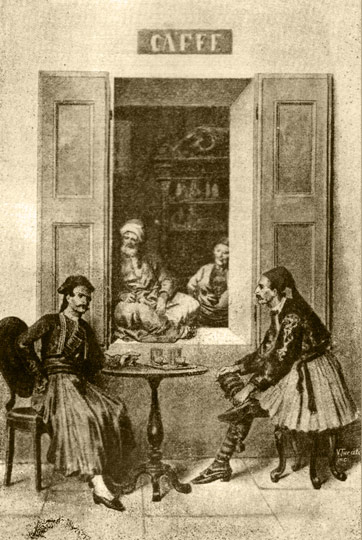
With the time, the cafés became associated with specific socio-cultural groups rather than national communities. Some cafés became the meeting places for the irredentists, Italian nationalists who advocated the return to Italy of Italian-speaking districts under Austrian-Hungarian rule such as Trieste, Gorizia, Istria and Dalmatia. Others were frequented by the bourgeoisie or by business men. There were also literary cafés, mostly frequented by intellectuals, writers and artists.
Soon, the city’s cafés became thè places to be, where people could mingle in the typical, friendly but anonymous, Triestine way. James Joyce, Stendhal, Kafka, Italo Svevo and Umberto Saba and the contemporary Triestine writers Paolo Rumiz, Fulvio Tomizza, or Claudio Magris each had their favorite café.
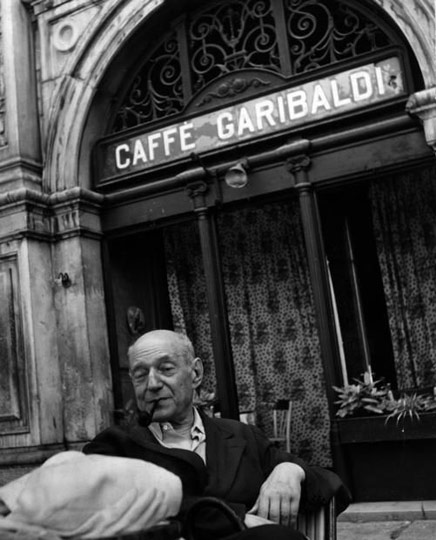
Unfortunately, many of Trieste’s historic cafés have been destroyed or transformed beyond recognition. Caffè Tergesteo, until recently located in the eponymous gallery on Piazza della Borsa, Bar Venier in Piazza Goldoni, Café Garibaldi, Caffè Flora and Caffè Orientale, the latter three in Piazza Unità d’Italia, are just a few examples of Trieste’s rich coffee-cultural heritage that have been lost to history.
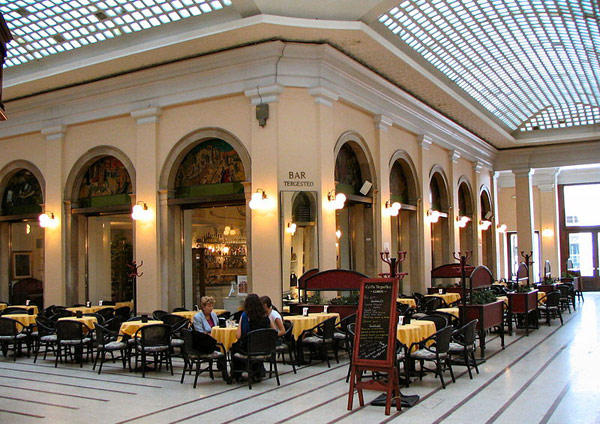
Among the ones of historic significance still operating today are the following 8 historic cafés and 2 historic pastry shops mentioned below:
1. Caffè San Marco
Via Battisti 18
34125 Trieste
Tel: +39 040 363538
Caffè San Marco is by far my favorite café in Trieste, and maybe even my personal pick among all historic cafés I visited in Florence, Turin and Rome. I loved the airy yet, at the same time, very cozy lay-out and the stylish interior decoration, all spiced up with hidden symbols and metaphors, which recall the origin of the coffee house and its irredentist spirit.
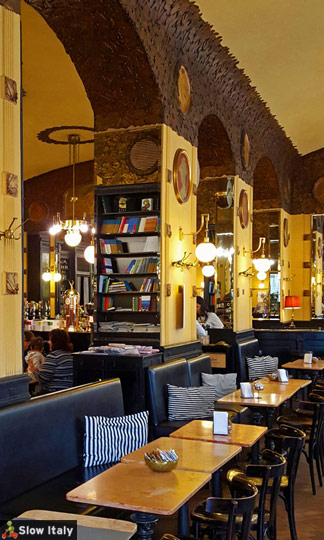
It is also one of the few coffee houses that has remained true to its tradition as a literary café. Indeed, since 2013 the café hosts the bookshop San Marco, adding an additional appealing touch for those who love to read and write in an ambiance surrounded by books, but not just books. Concerts, exhibitions and other cultural events are held here on a regular basis turning the café into a cultural hub just as it used to be in the beginning of the 1900s, when intellectuals, writers and irredentists gathered here. An inviting place where you come to read, write or contemplate the lively atmosphere soaking up the inspirational vibes that have been hanging in the air for centuries!
Not to mention their delicious chocolate and pear cake !
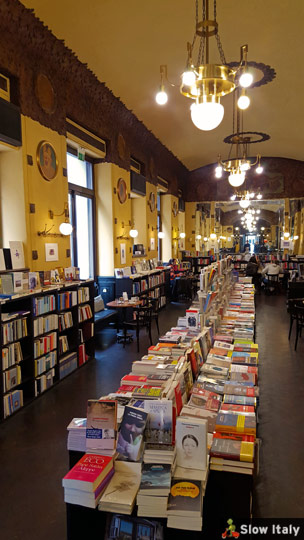
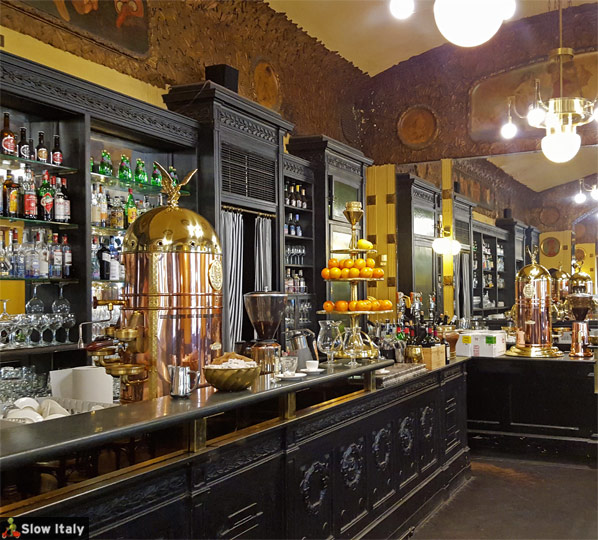
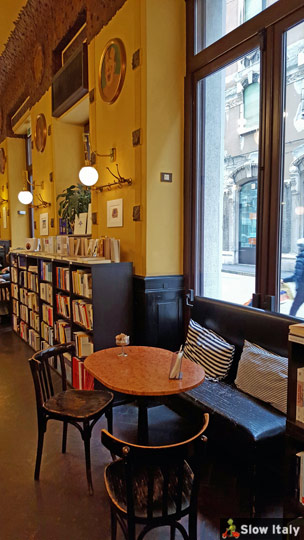
Opened on January 3 in 1914, the café was named after its first owner Marco Lovrinovich, a wine dealer. Originally, the Austrian authorities opposed the name claiming that it didn’t fit the Triestine tradition, as it sounded too Venetian. However, Lovrinovich claimed that he should be allowed to call the café after himself, and was eventually granted the permit. Yet, it seems that Lovrinovich liked to maintain the ambiguity as the café is full of references to the Venetian San Marco lion, with lion heads featured on the counter (designed by Conte), and an univocal decorative panel hanging in the side room. Even the wrought iron feet of the marble tables represent lion paws.
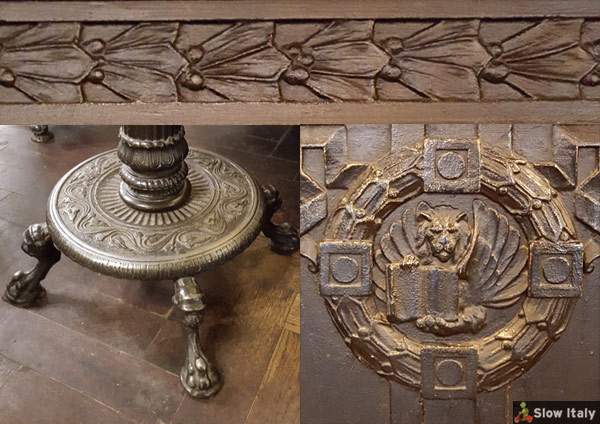
If you have a closer look you will also find other symbolic and metaphoric elements, such as coffee leaves and cherries, blended into the decoration of the furniture, walls and ceilings. Interesting are also the forty three river allegories representing rivers of Italy and the Friuli Venezia Giulia region, and the thirty six mask paintings, which adorn the walls throughout the café. Because of these Café San Marco was even dubbed Caffè delle Maschere at some point.

Intellectuals and writers, such as Italo Svevo, Umberto Saba, James Joyce, Gianni Stuparich and Virgilio Giotti all appreciated the cozy atmosphere and, because of its position a bit off the city center, the café also became a bastion for the irredentists, who probably chose the coffee house for its location. At the high time of Italian irredentism fake passports were even printed and distributed here.
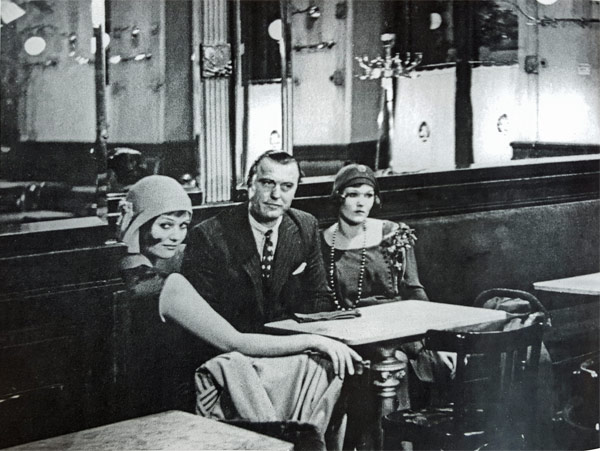
The venue was also used as a film set in 1962 for the movie Senelità (Careless in the US) by Mauro Bolognini based on the eponymous novel by Italo Svevo. In the photo below you can see Claudia Cardinale and Rada Rassimov.
The Television drama La Coscienza di Zeno 1987 by Sandro Bolchi with Johnny Dorelli in the role ofZeno Cosini was shot here in 1987.
2. Caffè degli Specchi
Piazza Unità d’Italia 7
34121 Trieste
Tel: +39 040 370187
Due to its central location in Piazza Unità d’Italia, Caffè degli Specchi has always been the barometer of the town’s city life and history. It is the only testimony of what was once Trieste’s main square lined with cafés, among which Caffè Garibaldi (under Palazzo del Municipio), Caffè Flora (in Casa Pitteri) and Caffè Orientale (under Palazzo Loyd), now part of the past.
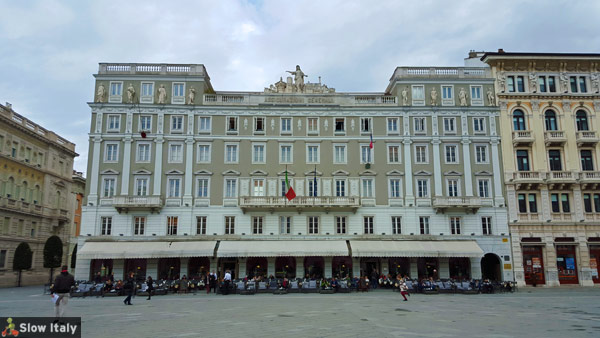
Palazzo Stratti, the building where Caffè degli Specchi is situated, was built by the Greek Nicolo’ Stratti, who was also the owner of the license “bottega da caffè”. Nicolò Privolo, also a Greek, opened the café in 1839. He decided to cover the walls with engraved mirrors, which each recounted a historical event that occurred in nineteenth century Europe. This was a smart strategic move rather than a purely esthetic one. Indeed, before electricity (electric lighting was only introduced in 1933), most visitors left at sundown because the cafés were dark. With the mirrors, candles and oil lamps were reflected a hundreds of times, illuminating the café with shimmering light, which allowed visitors to stay longer even after dusk. Today, only three of the original mirrors have remained in place.
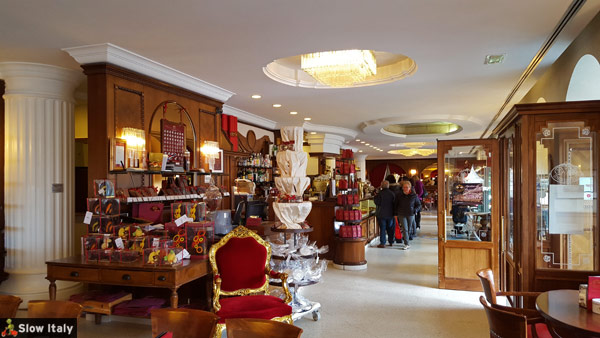
In the basement of the café there is relic piece of a wall of the ancient Castello Amarina built by the Venetians in 1370. Next to the site where the café was built there was an ancient church di San Pietro demolished in 1822.
The café was requisitioned in 1945 when the Anglo-American forces used it as headquarters for the Royal Navy. Until 1954, year when Trieste was annexed to Italy, locals were only allowed inside the café if accompanied by a British military.
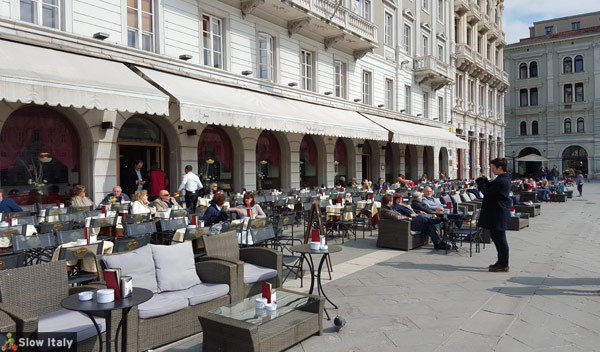
3. Antico Caffè Torinese
Corso Italia 2
34121 Trieste
Tel: +39 389 654 3611
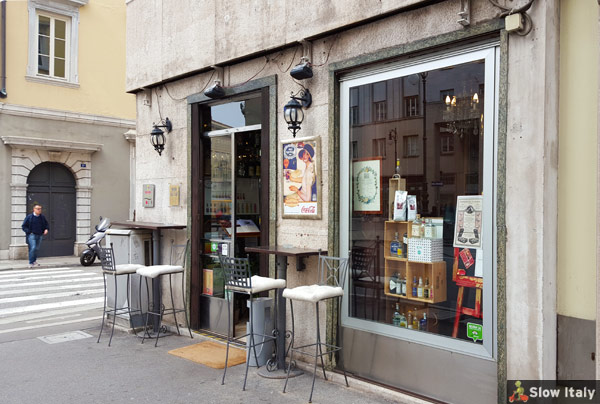
Antico Caffè Torinese was founded in 1915, at the corner of Corso Italia and Via Roma. It may not look like much from the outside, but step inside and you’ll be absolutely amazed. The café, where even the ceiling is covered with fine wooden paneling, is a little gem inside.
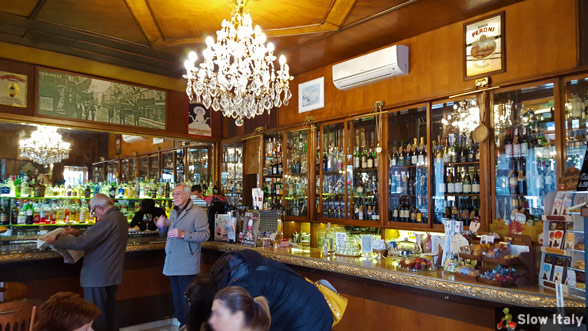
The interior made of precious teak and fruit tree wood is the work of cabinetmaker Giuliano Debelli (whose logo is visible on some pieces). Once you know that Debelli used to make the fine wooden interiors of transatlantic ships such as Saturnia and Vulcania (1925-1926), you’ll understand why the small café hints at the atmosphere of a luxury Belle Epoque passenger ship. The fixed furniture system made of wooden cabinets, drawers and shelves, and the magnificent crystal chandelier all beautifully work together to confer an aura of grandeur to an otherwise tiny space.
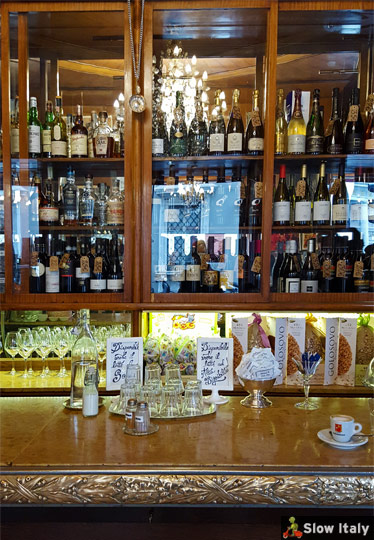
The counter in Art Nouveau style may be the only of its kind left in Trieste. The beautiful tin and lead border, a material that was previously only used for fishmonger counters, was temporarily removed by the owners during WWII to prevent it from being seized for the war effort.
A further peculiarity of the café is that is has no restroom, which is rather unusual, as a café with tables which is not intended as a take-away must have a restroom according to Italian law. However, as Antico Caffè Torinese started as a pastry and chocolate shop it had no bathroom originally. Now, the building has been listed under historical preservation protection so it can no longer be altered.
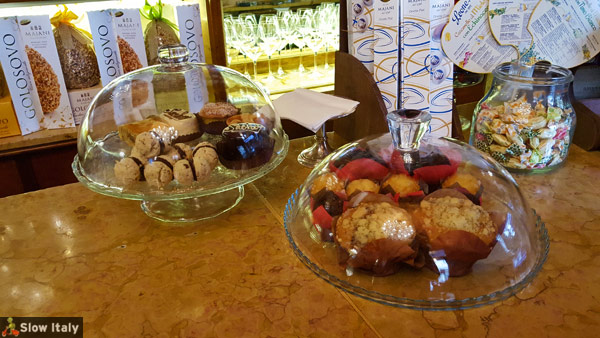
Like other historic cafés, the coffee house has its own blend of coffee, branded Antico Caffè Torinese.
4. Caffè Stella Polare
Via Dante 14
34122 Trieste
Tel: +39 040 632742
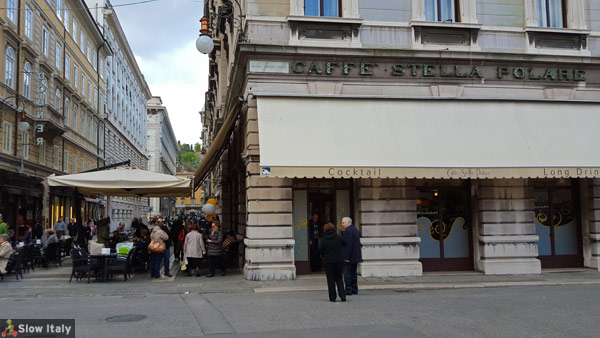
Founded in 1867, next to the Serbian orthodox church San Spiridione alongside the Grand Canal, Caffè Stella Polare has always been frequented by local merchants, citizens and intellectuals.
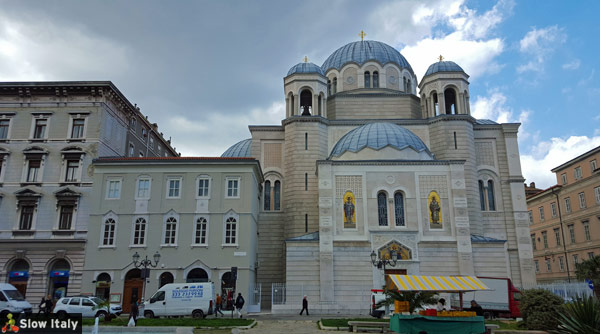
Originally the coffee house extended up until the Church San Spiridione and was also much deeper. In front of the coffee house was the canal, which at that time extended up to Via Dante Alighieri.
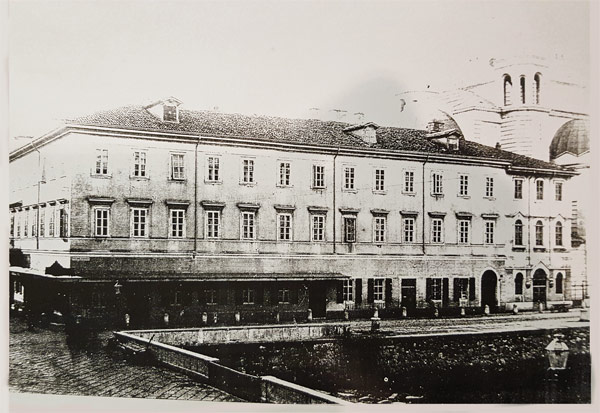
The coffee house was so spacious inside that it could contain several billiard tables and about 20 game tables.
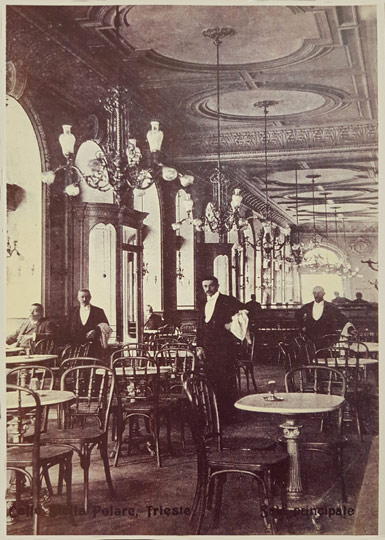
In the beginning of 1904, the old three-story building was torn down to make way for the current coffee house, while Café Stella Polare moved provisionally into a wooden pavilion, located opposite the Church of Sant’Antonio Nuovo.
At the end of WWII, during the Anglo-American occupation, the café was transformed into a dance hall frequented by local woman and American soldiers stationed in Trieste. Some of them met their future husbands here and moved overseas with them after the annexation of the city to Italy. However, with the time, the cost of maintaining the ball and game rooms became too high, and only the café part has survived to this day. The café has been completely renovated. Only the mirrors and the arches with carved stucco decoration are original.
5. Caffè Tommaseo
Piazza Tommaseo 4/c
34121 Trieste
Tel: +39 040 362666
Caffè Tommaseo is the oldest café of Trieste, founded in 1830. The venue was famous for its gelati and its concerts. Actually, it was the first in town to sell gelato at the beginning of the last century.
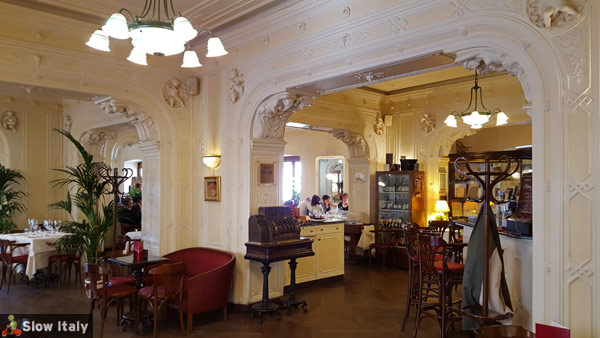
Originally, it was named Caffè Tomaso, after the first owner Tomaso Marcato. Located in the eponymous square, it has always been a meeting point for business men and politics. The interior alone, with its beautiful mirrors from Belgium, decorated ceilings and wooden chairs in Thonet style, is worth the detour. The café was restored in 1997 keeping the original sophisticated neo-classical style.
The writers and poets Pier Antonio Quarantotti Gambini, Pasquale Giuseppe Besenghi degli Ughi, James Joyce, Umberto Saba, Italo Svevo, Giani Stuparich were all habitués.
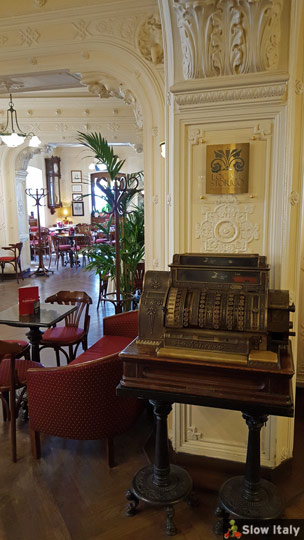
Under the rule of the Austro-Hungarian Empire the café, the café was the meeting place of the revolutionaries, as one can read from a sign:
Da questo Caffè Tommaseo, nel 1848, centro del movimento nazionale, si diffuse la fiamma degli entusiasmi per la libertà italiana.
6. Caffè Urbanis
Angle of Via del Teatro and Piazza della Borsa
34121 Trieste
Tel: +39 040 366580
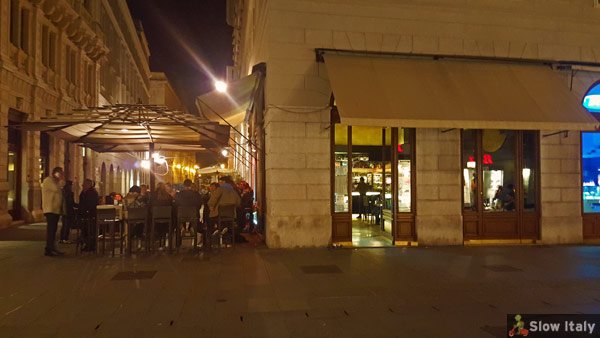
Started as a pastry shop in 1832, Caffè Urbanis is now one of the favorite bars frequented by the Triestine young people at night.
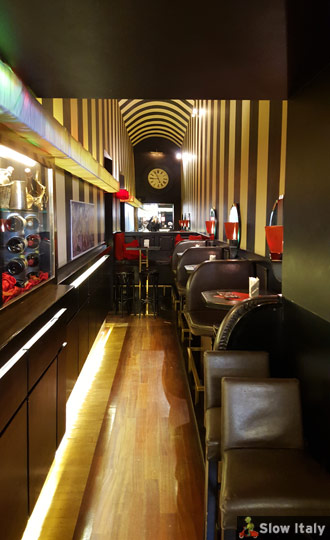
The interior has been elegantly renovated, leaving, however, little clue as to original layout and atmosphere.
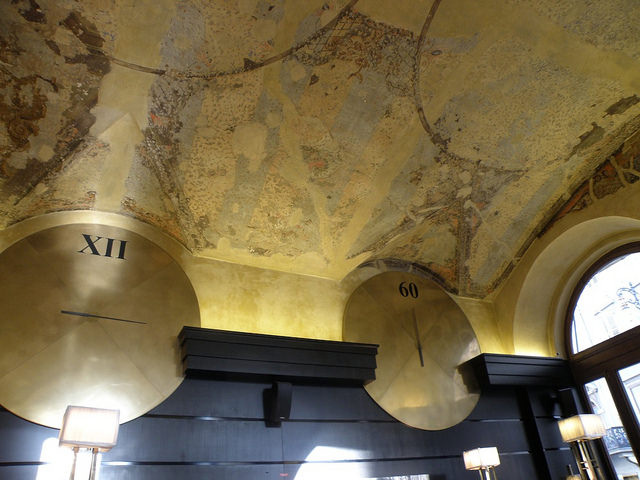
Worth seeing is the original mosaic pavement which contains various representations, the sea, the bora and mythological symbols. The foundation year is still visible on the windows and in the mosaic.
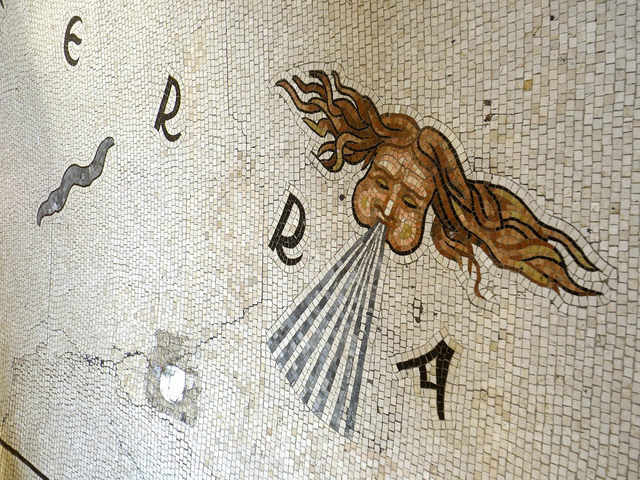
7. Bar Cattaruzza
Piazza Duca degli Abruzzi 1/D
34132 Trieste
Tel: +39 335 818 0170
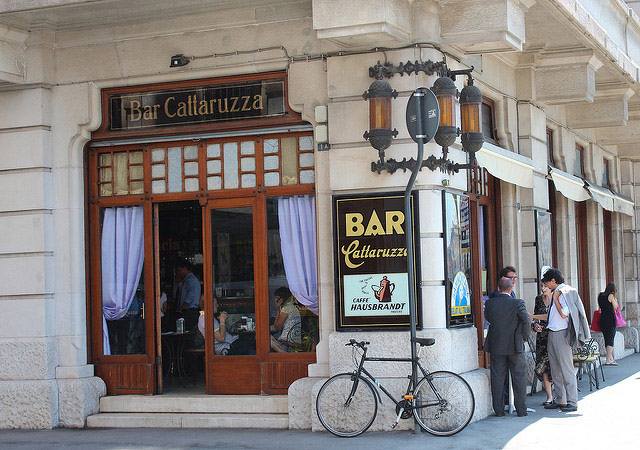
This small café was founded by the Cattaruzza family in 1938. It is housed in the historic building Palazzo Aedes, the first “skyscraper” built in Trieste in 1926-1928, inspired by the first red-brick skyscrapers of New York (hence the nickname “il grattacielo rosso” – red skyscraper).
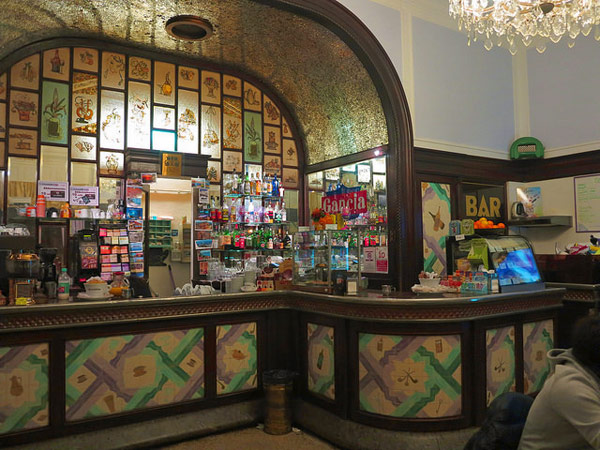
Local artists from the nearby Teatro Miela were habitués of this Art déco coffee house.
8. Gran Bar Italia
Piazza Carlo Goldoni 6
34122 Trieste
Tel: +39 328 407 8839
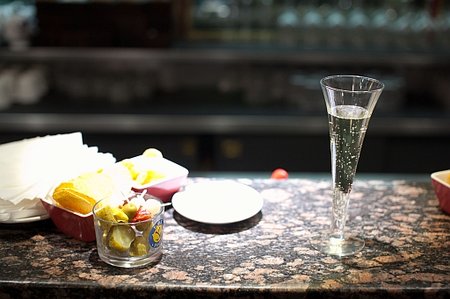
Gran Bar Italia is located under Palazzo Parisi in Piazza Goldoni. Opened in the 1920s, it was originally called Bar Grande Italia, which translates the spirit of that time.
9. Caffè Pasticceria Pironi
Largo Barriera Vecchia 12
34129 Trieste
Tel: +39 040 636046
Caffè Pasticceria Pironi is famous as the pastry house where James Joyce bought his favorite sweet treats, as he lived at number 32 in the same street for a while. Among his favorite cakes were the pinolate.
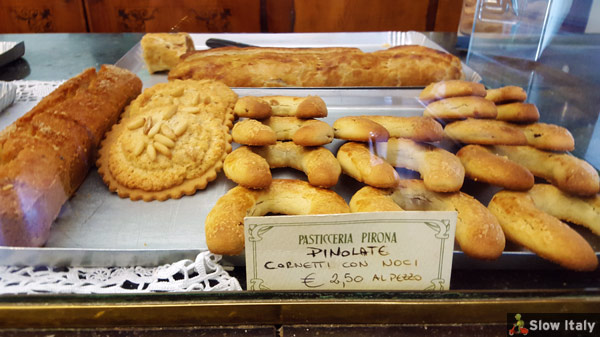
Sadly it is also the only remaining historic shop in the neighborhood of Largo Barriera Vecchia, as the demolition spree of the Thirties saw the former Caffè Bizantino and Caffè Réclame disappear.
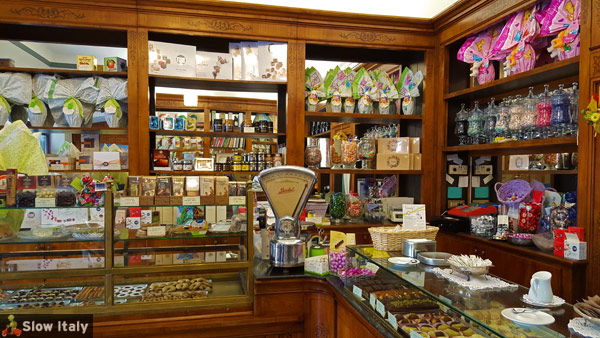
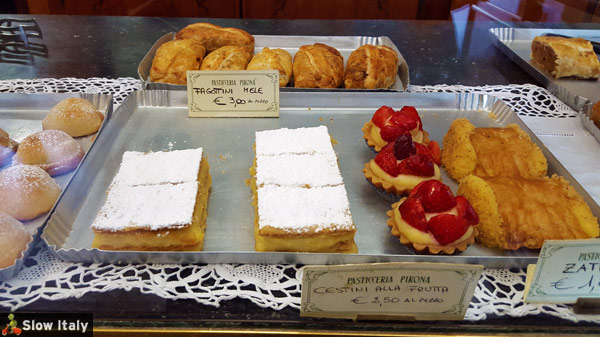
10. Pasticceria La Bomboniera
via Trenta ottobre 3
34122 Trieste
Tel: +39 040 632752
The Art Nouveau-style pastry shop La Bomboniera was founded by the Eppinger family of ungarian origin in 1836.
The all-time specialty of La Bomboniera is the Rigojansci, an antique cake that formed the base from which the Viennese pastry chef Demel created the Sacher Torte by adding layers of jam. The origin of the Rigojansci itself is attributed to a love story. Legend has it that it was created by the violinist Rigo Jangsi who wanted to seduce and surprise princess Clara who left her husband the Belgian prince Joseph de Caraman-Chimay out of love for him. The affair resulted in an international scandal.
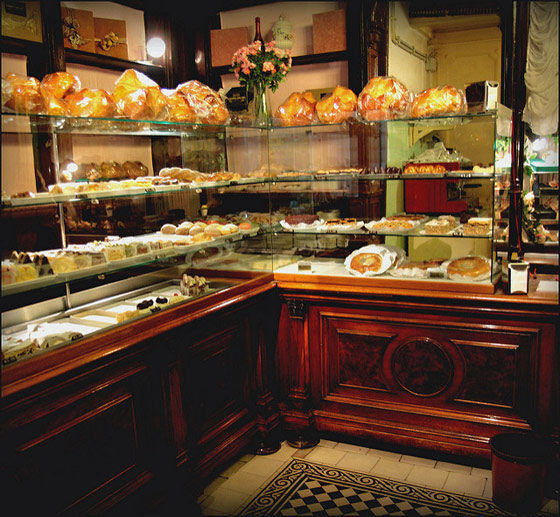
Photo credits: all photos © Slow Italy, except (from top to bottom): Caffè Garibaldi and Umberto Saba: via Pinterest – artemagazine.it; Bar Tergesteo by Paolo Tosolini; Caffè Urbanis mosaic and ceiling © lironmil; Caffè Cattaruzza © Mimi Amnell and Paolo Longo; Gran Bar Italia © www.granbaritalia.it; La Bomboniera © Paolo Longo.

